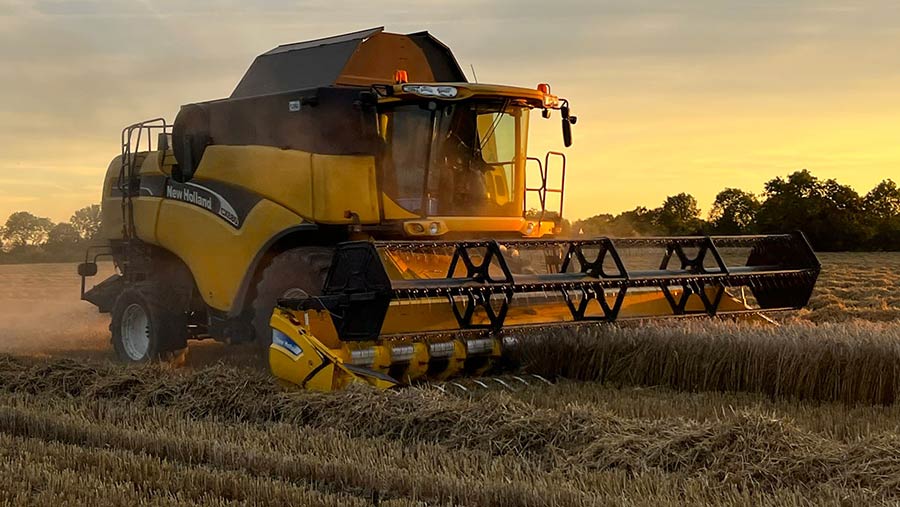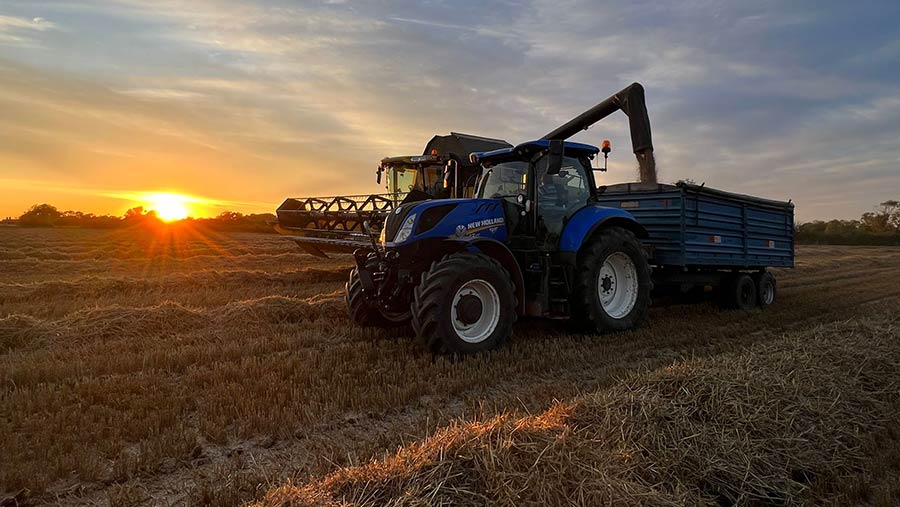Harvest 2023: Wheat quality suffering as Hagberg levels fall
 © Charles Anyan
© Charles Anyan Winter wheat crops are showing variable quality, with some growers seeing low Hagbergs – a measure of gluten quality – but reasonable protein levels.
Spring barley has been fairly good for yield, but crop have certainly missed the sunshine this year, while in Scotland some growers are seeing spring barley showing regrowth of green shoots after rain in July.
See also: Harvest 2023: Late-cut spring barley struggles for yield
Angus
At West Scryne Farm, near Carnoustie, James Porter harvested 11ha of Crome oilseed rape, a clubroot-resistant variety, in early August, which yielded a decent 4.9t/ha.
Next, his 40ha of Stokes winter wheat yielded 9.8t/ha and came off at about 16.5% moisture. All the wheat had been combined ahead of 97ha of Laureate spring barley.
“I have never combined all my wheat before starting any barley,” says James. “There is a lot of regrowth from the drought in June, then the wet weather in July. There is so much variation in one field.”
The spring barley is grown for seed, so glyphosate cannot be used. “One field yielded 9.1t/ha, then we’ve also cut fields that have been under 7.4t/ha, so very variable,” he adds.
Some of the remaining barley does not look like it will be ready for another two weeks, due to being late-sown in April, given the late spring.
North Yorkshire
Heading south to High House Farm, near Richmond, Phil Dowson has completed his cereal harvest. It got off to a good start, with 10ha of Tardis winter barley yielding 8.6t/ha. The oilseed rape was mixed, with one 8ha field yielding 3.7t/ha.
“We had two smaller fields that were hit by flea beetle. A lot was unharvestable,” he says.
Then 40ha of feed wheat averaged a specific weight of 76-78kg/hl. The Skyscraper second wheat was disappointing, yielding 6.2t/ha, but the Dawsum first wheat yielded a decent 11t/ha. All the feed is sold to a local pig farm.
Phil says: “It has been wet underfoot. Thankfully we have got a new contract farmer in with a combine on tracks, so it has not made much of a mark, and balers have managed.”
High fertiliser prices meant he had planted more winter beans in place of winter wheat, but they yielded a disappointing 6.1t/ha. “The neighbours have a bit of spring barley left to cut, but that’s about it,” he adds.
Lincolnshire

© Charles Anyan
The sunshine was missed in July at Belle Vue House, Springthorpe, near Gainsborough, meaning the Skyfall milling wheat only just reached milling specifications for Warburtons.
The 150ha of winter wheat, which also included Cranium and Gleam feed wheat, averaged 9t/ha.
“That is slightly lower than our five-year average,” says Charles Anyan. “I’ll be growing Gleam for our second wheat again as it performed well this year, then Cranium will be swapped for Dawsum next year.”
The average protein content was 12.4%, lower than Charles would have liked, and Hagbergs were at 200-300. Where protein levels were high, Hagberg values were often low, he says.
Then 30ha of Planet spring malting barley came off at 14-15% moisture content and yielded 7.4t/ha with reasonable quality. But the 50ha of high oleic, low linolenic (Holl) oilseed rape was a disaster. “The dry conditions it got planted in last August meant it didn’t germinate,” says Charles.
Kent
In sharp contrast, Robert Spencer’s 60ha of Ambassador oilseed rape was his best for three or four years at Lower Garrington Farm, near Canterbury, yielding 4t/ha. But his 250ha of Skyfall winter wheat was disappointing on quality, despite good yields of 10.25t/ha.
“All the Hagberg had gone, in the 120-150 range, but specific weight and proteins were excellent,” says Robert. Skyfall was a second wheat, and as a result of the poor Hagberg it went for feed.
However, the 100ha of Crusoe did better, yielding 11t/ha as a first wheat, achieving more than 13% protein content, 76kg/hl specific weight, and 250 Hagberg. Another first wheat, Dawsum feed wheat, yielded 11.2t/ha and averaged 73kg/hl specific weight.
Lastly, 40ha of Planet spring malting barley yielded 7t/ha, but Robert says two-thirds of it failed malting criteria for low germination. There is still 150ha of Isabel spring oats to combine, 50ha of wheat, and spring beans.

